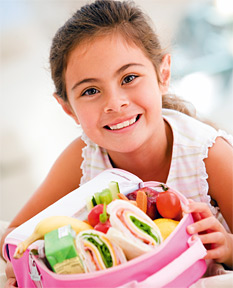Healthy Back-to-School Lunches
By Dr. Claudia Anrig
As parents begin the annual back-to-school scramble for clothes, supplies and other school essentials, many will overlook one of the most important necessities for the school year - healthy lunches.
It's common knowledge that despite attempts to improve the state of affairs, the school cafeteria is essentially just another franchise; with limited exception and despite facing increasing scrutiny, school cafeteria foods aren't healthy and well-balanced. Chicken fingers, pizza and refined (white) bread, rice and pasta just don't cut it when it comes to good nutrition, and these types of foods are prevalent in school cafeterias frequented by 5-year-olds to 17-year-olds. And what's more, vending machines offer chips, cookies, sodas and all kinds of other junk foods that children shouldn't be eating, certainly not without parental supervision.
This unhealthy environment has created a challenge for parents that many have decided to ignore, whether by design or just because they lack the time and energy to pay closer attention. Many parents rationalize that the rest of their children's meals are healthy and nutritious, so they can be lax regarding school meals. This is a misconception, especially if you consider not only what is being served in the majority of school cafeterias, but also that most kids are at school for at least a half a day and up to a full day, depending on their age.
What's Being Served?
 Although programs have begun to appear over the past few years addressing the problem, the fact is that not much has changed. The majority of entrees served on school campuses include pizza, Sloppy Joes, cheeseburgers, spaghetti, hot dogs and corn dogs. It's rare that you will see anything made with fish and chicken, unless it's fish sticks and chicken nuggets, which contain processed meat that is breaded and deep fried. This is just not nutritious. It's time to accept the fact that raising healthier children means they won't be eating school lunches, but instead will need to be provided lunch from home. Here are some suggestions for how even the busiest parents can do it.
Although programs have begun to appear over the past few years addressing the problem, the fact is that not much has changed. The majority of entrees served on school campuses include pizza, Sloppy Joes, cheeseburgers, spaghetti, hot dogs and corn dogs. It's rare that you will see anything made with fish and chicken, unless it's fish sticks and chicken nuggets, which contain processed meat that is breaded and deep fried. This is just not nutritious. It's time to accept the fact that raising healthier children means they won't be eating school lunches, but instead will need to be provided lunch from home. Here are some suggestions for how even the busiest parents can do it.
Perfect Packing
Part of putting together a healthy packed lunch is having the right storage containers. After all, you want your child to look forward to eating their meal. If foods that are intended to be cold end up warm by lunchtime, and/or if their lunch box is overflowing with items that fall out as soon as they open it up, children will quickly be turned off. Be sure to use an insulated lunch box that will hold up to four small food containers and a thermos. When purchasing the containers, you should buy at least two sets; this will help you to avoid having to wash a them each night. As for the thermos, be sure that it is the wide-mouth variety; this will allow for a wider variety of foods to accompany your child to school.
The Beverage
When it comes to healthy lunches, milk, juice and soda should be avoided at all cost. The American Academy of Pediatrics says that juice consumption is contributing to cavities and gastrointestinal issues for children, while milk has proven to be a common food allergen. Your best option is to encourage your child to drink water. This can be done by providing water for them in their lunch box using a stainless-steel thermos or by placing ice cubes in their thermos in the morning. By lunchtime, they will have begun to melt and, in the meantime, they will have helped to keep the other items in the lunch box nice and cold.

